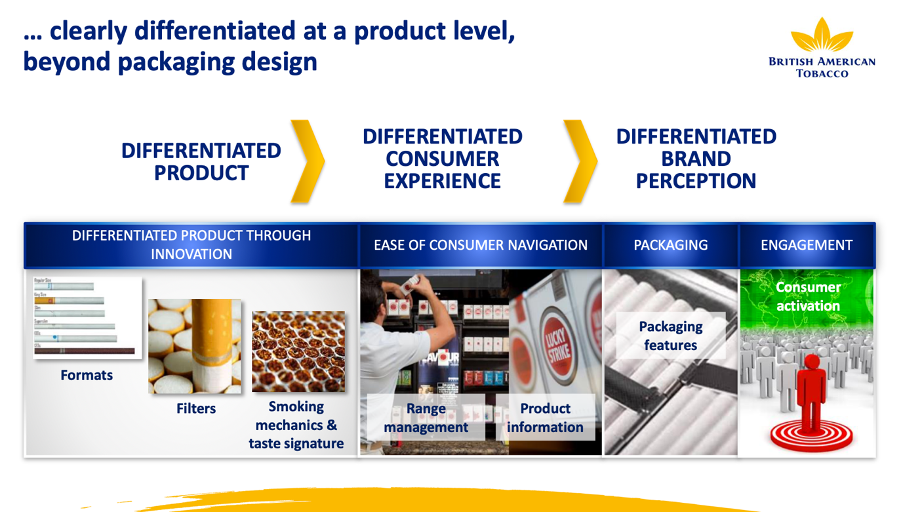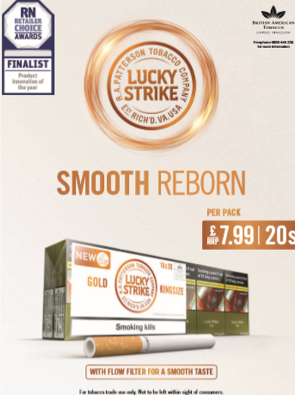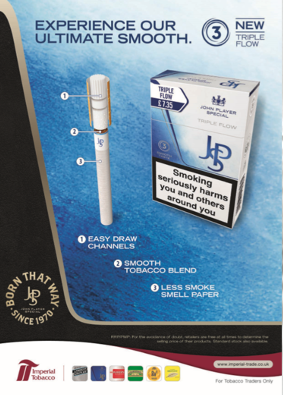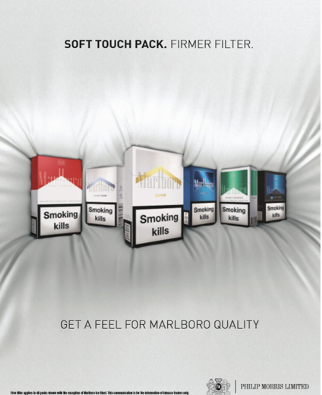Cigarette Filters
This page was last edited on at
Key Points
- Filtered cigarettes have historically been marketed as safer than unfiltered cigarettes. Despite evidence showing that they are not less harmful and have increased health risks, they are still perceived by consumers as less harmful.
- Today, new variants of filtered cigarettes continue to be promoted by the industry to retailers.
- The high environmental cost of cigarette filters is being used by the industry to facilitate engagement with the UK government, in an attempt to repair its damaged reputation and maintain profits.
- The tobacco industry should bear the responsibility for both the environmental and health harms of cigarette filters.
More than 90% of cigarettes sold worldwide have a filter.12 These filters are typically made of a plastic called cellulose acetate,3 and are not biodegradable.4
History of industry marketing
‘Safer’ and ‘healthier’
Cigarette filters have been referred to as the “deadliest fraud in the history of human civilisation”.5 Filters were initially used from 1860 to 1920 to prevent particles of tobacco entering the mouth. The first major filtered cigarette, called Parliament (Brown and Williamson), was introduced in the USA in 1931. Viceroy cigarettes (also Brown and Williamson), introduced in 1936, were the first filter cigarette sold at a popular price.1
During the early 1950s, evidence demonstrated causal links between smoking and lung cancer.67 The tobacco industry responded by introducing filters to reassure smokers that it was taking action to make cigarettes safer,2 and to promote an alternative to quitting.8 In 1950, cigarettes with cellulose acetate filters were introduced, capturing 1% of the market share.1
Many new filters were launched between the mid-1950s to mid-1960s and, according to a Philip Morris document from 1966, proved to be an “‘effective advertising gimmick’”.89 Over the same period, industry spending on advertising tripled to approximately US$150 million, at least partly accounted for by the promotion of filters.8
In 1964, the US Surgeon General’s report on smoking and health concluded that smoking caused lung cancer.10 Philip Morris (PM) claimed that this report missed an opportunity to promote the health benefits of filters. In 1966, PM conducted market analysis for a ‘health cigarette’, which concluded that “the illusion of filtration is as important as the fact of filtration”.8
‘Light’ and ‘mild’ cigarettes
In the 1970s, with more studies confirming the damaging health impact of smoking, tobacco companies started introducing ‘light’ and ‘mild’ cigarette brand variants.8 Japan Tobacco International was the first tobacco company to introduce a cigarette with ‘mild’ in the brand name.11 Such cigarettes, which initially were supported by public health,12 had perforated filters.2
Industry research using standard smoking machine tests found that filter ventilation reduced the concentrations of tar and nicotine in the inhaled smoke,13 as well as making cigarettes taste lighter and milder.1415 However, smoking machines do not precisely mirror real-life cigarette use in smokers. When their nicotine intake is reduced smokers typically engage in ‘compensatory smoking’; they take more frequent and deeper puffs to satisfy nicotine cravings,1617 and could cover the ventilation holes in the filters with their fingers.1819 Research on industry documents shows that Brown & Williamson, developer of the first major filtered cigarette, was aware of smokers’ practice of compensating for filter ventilation during the design process.20
Despite being aware by the 1970s, that smokers smoked filtered cigarettes differently to the machines used in testing, there was an industry-wide movement towards marketing filtered cigarettes as ‘safer’.21 Advertising slogans for such cigarettes referred to “miracle filter tips”.8 There was a switch from regular products to new products, such as filtered cigarettes, particularly among female and older smokers. However, overall smoking rates stayed the same across this period.8
No benefit to health
Filters have been marketed as a means to reduce smoking-related health risks,2 although evidence to date does not support this claim. Despite common perception, research has shown that cigarette filters do not offer any health benefit and filtered cigarettes are not less harmful than unfiltered cigarettes, for either smokers14 or passive smokers.22 The compensatory behaviour exhibited by smokers using filtered cigarettes not only negates any potential reduction in health risks, but can actually increase health risks. The 2014 US Surgeon General’s Report on smoking and health concluded that cigarette filter ventilation, found in ‘light’ brand variants, has caused an increase in lung adenocarcinomas (cancers found in peripheral areas of the lungs) among smokers, due to altered puffing and inhalation associated with ventilated filters.23 This means smokers inhale carcinogens more deeply into the lungs14 and small particles in tobacco smoke are increasingly deposited in small airways.23 There is also a risk of smokers inhaling fibres from filters.24
Consumer (mis)perceptions
Smokers and non-smokers incorrectly perceive that ‘lighter’ brand variants are less damaging to health. Malboro Gold (previously ‘light’) smokers are more likely than Malboro red (‘full strength’) smokers to rate their cigarettes as weaker, and lower in nicotine and tar, as well as less harsh and mild tasting. However, this is not demonstrated by clinical evidence on biomarkers of exposure.25
The evidence on filters also shows that:
- Filter marketing slogans imply cleanliness and reduced risk through improved filtration,26 hygiene,27 ‘cleaner’ stubbing out, less smoke smell, and a smoother smoking experience.28
- Smokers perceive cigarette packs with a picture of a filter as significantly more likely to taste smooth, deliver less tar and be lower risk.29
- The colour of cigarette packs is associated with filter ventilation. Filtered cigarette packages are associated with brighter and less saturated colours.30
- White filter tips reinforce this perception of reduced harm.3132 Young people in particular perceive cigarette packs with references to filters as significantly less harmful than packs without references to filters.33
Global Regulation
Maximum tar, nicotine and carbon monoxide levels
The European Tobacco Products Directive sets maximum emission levels for tar, nicotine and carbon monoxide (TNCO) for cigarettes sold in the EU (10mg tar, 1mg nicotine and 10mg carbon monoxide), as measured using the ‘International Standards Organization (ISO)’ method.34 This method has been criticised for allowing manipulation through filter ventilation, as smokers close the holes in the filter with their fingers and lips. It produces artificially lowered levels of TNCOs, and doesn’t account for smokers’ compensatory behaviours.35
An alternative method, called ‘Canadian Intense’, tapes the ventilation holes and captures larger puffs with a shorter break in between. As a result, the Canadian Intense method usually measures higher amounts of TNCOs.3436 This method was adopted by the World Health Organization and is also referred to as the WHO Intense method.373839
The WHO advocates for methods of testing and measurement developed independently from the tobacco industry:
“The industry exerts considerable influence on the adopted ISO testing methods for tobacco and tobacco products, as they make up by far the largest percentage of national and international technical committees.”39
In 2018, the Dutch National Institute for Public Health and the Environment (RIVM) conducted a study on one hundred cigarettes for sale in the Netherlands using the WHO Intense method. The study found TNCO emissions between 2 and 3 times higher than the legally permitted maximum during real-life consumption, whereas the emissions of all cigarettes remained under the legal thresholds when measured with the ISO method.354041 An RIVM study recommended that a different, independent measurement method be used instead of the ISO method, rather than one “largely influenced by the tobacco industry”.35 The WHO also recommends the extension of tobacco product sale regulation and tax policy to include single-use cigarette filters.4
As of January 2021, 93 countries worldwide have banned or restricted misleading packaging and labelling.42 Descriptors of ‘light’ and ‘mild’ on cigarette packs have been banned in the European Union and Brazil since 2003. Similar policies have been in place in Australia since 2005, Canada since 2007 and the USA since 2009. Consequently, misperceptions about ‘light’ cigarettes reduced between 2002 and 2009 in smokers across Canada, the UK, and Australia.4344
The tobacco industry continues to use filter ventilation to imply that filtered cigarettes are safer, by using packaging to indicate ‘light’ or ‘mild’ cigarettes, despite the introduction of bans on misleading packaging and labelling. This deceptive marketing is typically not regulated by plain packaging legislation.4344 To evade this legislation, the tobacco industry is exploiting loopholes by:
- Using colour named brands to indicate former ‘lights’ brands, which were associated with filter ventilation,45 while maintaining the same product characteristics.46
- Innovating filters, which enables continued differentiation between products and promotion to investors (see Figure 1).47

Figure 1: Slide from BAT Investor Day 2015 presentation on marketing strategy. (Source: British American Tobacco)
Innovations in filters
The tobacco industry uses product innovation as a tactic to grow sales and circumvent legislation.
Flavour capsules
Since being introduced in 2007, cigarettes with flavour capsules in the filter have grown exponentially worldwide. In 2017, the market share of capsule cigarettes was greatest in Chile (36%), followed by Peru (34%), Guatemala (32%), Mexico (22%), and Argentina (17%).48 (More details on the capsule market can be found on Flavoured and Menthol Tobacco and Menthol Cigarettes: Industry Interference in the EU and UK.)
Filters can contain one or two different flavour capsules, with flavours including mint, fruit, or those that imitate drinks, including cocktails. In 2014, flavour capsules were also introduced for roll-your-own cigarettes in the UK and Korea. These types of filters enable tobacco companies to market and differentiate their brands, despite regulations on plain packaging and health warnings.48
Capsules in cigarette filters are strategically marketed to consumers, through a ball and/or power button symbol, coloured images (blue or green), and phrases such as “activate” and “pop it”.49 The evidence shows that cigarettes with flavour capsules are associated with misperceptions of harm50 and increased attractiveness among young smokers.51
Recessed and firm filters
Since plain packaging legislation was introduced in Australia in 2012, the tobacco industry has undermined the legislation by introducing recessed filters and firm filters. Recessed filters have a hollow section at the mouth end, whereas firm filters look similar to standard filters but have a firmer feel. Recessed and firm filters reduce perceived harm and increase appeal.52 Packs labelled with these new filters have mostly replaced the common products in leading brands.53
As the UK prohibits tobacco advertising and point of sale display, and enforces plain packaging legislation,44 the tobacco industry uses the retail trade press to promote tobacco products to retailers rather than use traditional marketing. This includes adverts claiming improved filters (see Figures 2-4). Before and around the introduction of plain packaging legislation in the UK, tobacco companies introduced filter innovations such as recessed filters.47
The retail trade press advertised British American Tobacco’s Lucky Strike with a recessed filter (see Figure 2);54 and Imperial’s JPS Triple Flow with a recessed filter in 2016 (see Figure 3);55 and PMI’s Malboro with a firmer filter in 2015 (see Figure 4).56

Figure 2: BAT advert for Lucky Strike. (Source: Retail Newsagent, 2016)

Figure 3: Imperial Tobaccco advert for JPS Triple Flow. (Source: Retail Newsagent, 2016)

Figure 4: PMI advert for Marlboro. (Source: Retail Newsagent, 2015)
Environmental impact
Cigarette filters are among one of the top ten most common plastics in the world’s oceans, representing a major environmental hazard. 4.5 trillion cigarette butts (used filtered cigarettes) are deposited into the environment each year. It has been estimated that cigarette butt waste will increase by 50% in 2025.57
Cellulose acetate filters are photodegradable, as ultraviolet rays from the sun reduces the filter to smaller pieces.58 However, they are not biodegradable because they are made of acetyl molecules.4 They only lose an average of 38% of mass in two years of decomposition59 and contain multiple toxic substances which infiltrate the environment.6061 Cigarette filters affect the microbial diversity of coastal sediment62 and the mortality of animals.63
Single use plastics were banned across the EU in 2019,64 although this does not cover plastic cigarette filters. As of 2021, tobacco companies must increase awareness of the plastic in cigarette filters and contribute financially to dealing with cigarette butts.65 However, these measures were resisted by the tobacco industry.66
Multiple options have been suggested to reduce the environmental impact of cigarette filters, including:
- Prohibiting filter ventilation, alongside low maximum standard tar, nicotine, and carbon monoxide yields, which would make cigarettes less appealing and promote smoking cessation;67
- Combining plain packaging legislation with removing colour as a distinguishing feature across cigarette packs, to remove the association between packaging elements and filter ventilation;30
- Labelling filtered cigarettes with warnings advising smokers to dispose of the product responsibly;58
- Implementing deposit/recycling laws in which a deposit is initially paid, and returned once the used cigarette is returned;58
- Implementing a waste tax on cigarettes which could be used to fund research;58
- Bringing litigation against the tobacco industry;58
- Making biodegradable filters mandatory;58
- Implementing fines for littering and increasing consumer education and responsibility.58
Biodegradable filters
Given the high environmental cost of cigarette filters, there is growing concern about the need to develop alternatives to current methods of disposal,68 and increase the biodegradability of filters.69 The tobacco industry is using growing environmental concern to exploit a loophole in the Framework Convention on Tobacco Control (FCTC) and as a tactic: to justify and enable interaction with the UK government.70 This is a greenwashing tactic used by the tobacco industry. Tobacco companies promote their environmental campaigns and activities, in order to increase sales and divert attention away from the health and environmental harms of cigarette filters.
The tobacco industry may see biodegradable filters as a method to combat the social unacceptability of smoking and improve the industry’s public image.7172 However, biodegradable filters still have negative impacts; they would still leach harmful chemicals into the environment if not discarded properly.60
The tobacco industry’s primary motive is to rehabilitate its reputation.71 Partnerships between public health and environmental advocates could increase pressure on tobacco companies to take responsibility for the environmental and health harms of cigarette filters,7172 and increase support for regulation.73
TobaccoTactics Resources
Tobacco Control Research Group (TCRG) research
- Evans-Reeves, K. Lauber, K. Hiscock, R. The ‘filter fraud’ persists: the tobacco industry is still using filters to suggest lower health risks while destroying the environment, Tobacco Control, 26 April 2021, doi:10.1136/tobaccocontrol-2020-056245
- R. Hiscock, K. Silver, M. Zatonski, A. Gilmore, Tobacco industry tactics to circumvent and undermine the menthol cigarette ban in the UK, Tobacco Control, 18 May 2020, doi:10.1136/tobaccocontrol-2020-055769
For a comprehensive list of all TCRG publications, including research that evaluates the impact of public health policy, go to TCRG publications.